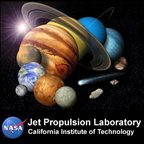
Podcast for audio and video - NASA's Jet Propulsion Laboratory
Summary: Video and audio podcasts from NASA's Jet Propulsion Laboratory feature the latest news on space and science findings from JPL and NASA. Topics include discoveries made by spacecraft studying planets in our solar system, including Mars, Saturn and our home planet, Earth. Missions also study stars and galaxies in our universe. Other topics cover tips for amateur astronomers and updates from the Mars Rover and Cassini missions.
- Visit Website
- RSS
- Artist: Video and audio podcasts
- Copyright: no copyright
Podcasts:
Asteroids, planets and rare meteor showers, oh my! June skies alight with stellar happenings.
Radar data of asteroid 1998 QE2 obtained on May 29, 2013.
When Asteroid 1998 QE2 makes its closest approach to Earth on May 31, 2013, it promises to be a bonanza for radar science.
Created with the help of supercomputers, this simulation shows the formation of a massive galaxy during the first 2 billion years of the universe. Hydrogen gas is gray, young stars appear blue, and older stars are red. The simulation reveals that gas flows into galaxies along filaments akin to cosmic bendy, or swirly, straws.
This simulation shows the merging of two massive galaxies, sped up to cover 1.5 billion years of time. The merging galaxies are split into two views: a visible-light view is on the left, in which blue shows young stars and red indicates older stars and dust. The view at right shows emission from dust, which is what infrared telescopes like the Herschel Space Observatory see. When the galaxies finally merge, the strong burst of star formation can be seen best in infrared views.
Curiosity prepares for a second drilling and a tutorial on the complicated choreography to get the drill sample to her instruments.
Curiosity gets new software and new capabilities for the long trek to Mt. Sharp.
Spot popular astronomical sights this month including nebulae, a galaxy trio and the site of a recent planetary discovery.
Narrated video about a hurricane-like storm seen at Saturn's north pole by NASA's Cassini spacecraft
This movie, made from images obtained by NASA's Cassini spacecraft, shows the clouds of a hurricane-like storm, which circulate around the north pole of Saturn out to 88.5 degrees north latitude.
NASA's Curiosity finds that the Red Planet doesn't have the same atmosphere it used to.
This artist's animation depicts an ultra-dense dead star, called a white dwarf, passing in front of a small red star.
Saturn's north pole is now tilted towards Earth, giving us the best view of the rings since 2006.
This animation illustrates the painstaking work performed by scientists to extract the oldest light in our universe, called the cosmic microwave background, from maps of the whole sky taken by the Planck mission.
This artist's animation depicts the "life" of a photon, or particle of light, as it travels across space and time, from the very early universe to the Planck satellite.